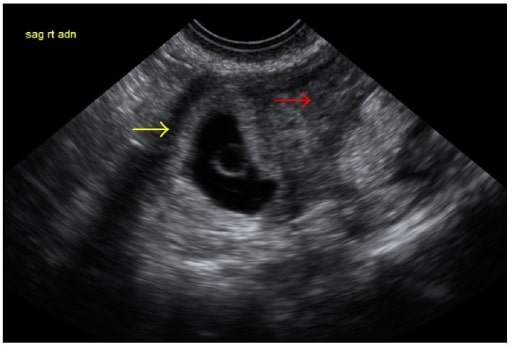Playlist
Show Playlist
Hide Playlist
Ectopic Pregnancy: Examination
-
Emergency Medicine Bord Ectopic Pregnancy.pdf
-
Download Lecture Overview
00:01 Now, what are patients gonna present with? What are the things they’re gonna come in with? So first of all, they may have missed a menstrual period. 00:08 They may have missed their cycle or their cycle may have been irregular in the last month, it may have lasted only for a day whereas normally it lasts for four, and for some patients, this may be very obvious. 00:18 They maybe the patient that has the app on their smartphone and they take... you know, they watch it very, very closely. 00:24 For other patients, it maybe a little less obvious. 00:26 Maybe they have irregular menses. 00:28 Maybe they just don’t pay attention quite as much. 00:30 Patients may present also with abdominal pain. 00:34 The abdominal pain may be peritoneal or more severe and someone with a ruptured ectopic pregnancy. 00:40 So if a patient has a pregnancy that was in the tube or in the cornua, or another location that ruptured, that’s gonna cause severe pain. 00:48 That’s gonna cause peritoneal symptoms because the peritoneal cavity is full of blood. 00:53 Rupture with a lot of blood in the abdominal cavity may also radiate to the shoulder. 00:59 So radiation of pain to the shoulder can indicate a ruptured ectopic pregnancy. 01:04 Now, early on in an ectopic pregnancy before the rupture, the patient may just have pain localized, one adnexa or lower portion in the abdomen or the other, so either the right or the left adnexa, or just in the lower abdomen in general. 01:18 What we’re talking about here with these words, the peritoneal pain, the severe pain, is that patient who has a ruptured ectopic pregnancy. 01:26 Patients may also experience vaginal bleeding. 01:30 The vaginal bleeding is generally not severe, so usually, it’s a small amount of vaginal bleeding. 01:35 That can help distinguish it from a miscarriage. 01:37 Patients who are having a miscarriage can have a very large amount of vaginal bleeding, so this may help differentiate it a little bit when you’re thinking about the differential diagnosis. 01:49 What will you see on physical examination? On physical examination for patients who have a ruptured ectopic pregnancy, patients may have tachycardia, so an elevated heart rate and low blood pressure. 02:01 For patients who are pregnant who come in tachycardic with hypotension, the patient may have syncopized or passed out at home, that is a ruptured ectopic pregnancy for that patient until proven otherwise. 02:14 For that patient, you need to make sure you get things moving for them quickly. 02:17 You might wanna do a bedside ultrasound to evaluate. 02:20 Involve the OBGYN team. 02:22 Tachycardia and hypotension plus a positive pregnancy test should make you very concerned. 02:27 On abdominal exam, the patient may have tenderness of the abdomen. 02:32 It might be diffused depending on if the pregnancy is ruptured or not, or it might be more localized to the lower abdomen. 02:38 And then, you’ll wanna perform a pelvic exam. 02:41 On the pelvic exam, the patient may have cervical motion tenderness. 02:45 When you move their cervix, it may cause them discomfort. 02:48 You might be able to feel an adnexal mass so either on the right or the left when you’re doing your bimanual exam, you may feel a mass. 02:58 And you may also see vaginal bleeding which is generally relatively light. 03:02 It’s important to remember that the history and physical exam for ectopic pregnancy are nonspecific. 03:10 You really need to maintain a high level of suspicion for this diagnosis in patients with lower abdominal pain and vaginal bleeding in early pregnancy. 03:18 I would say this is your rule out diagnosis when patients come in with bleeding and pain in early pregnancy. 03:26 I even go so far as to say that I have a few rules in emergency medicine. 03:30 One of them is that I get an ultrasound for all of these patients to evaluate for ectopic pregnancy because this can potentially be a life threatening diagnosis. 03:39 An ultrasound is generally easy and safe to obtain. 03:45 Please remember, it’s always important to start with a comprehensive abdominal and pelvic examination to test for other diseases. With this examination you can try and rule out diagnosis such as appendicitis, ovarian cysts, gynaecological tumors and molar pregnancies. A speculum examination to rule out any local causes of bleeding is needed.
About the Lecture
The lecture Ectopic Pregnancy: Examination by Sharon Bord, MD is from the course Abdominal and Genitourinary Emergencies.
Included Quiz Questions
In a patient suspected of having an ectopic pregnancy, radiation of pain to which location will indicate the possibility of a ruptured ectopic pregnancy if abundant blood is present in the abdominal cavity?
- Radiation to shoulder
- Radiation to right upper abdomen
- Radiation to periumbilical area
- Radiation to right lower abdomen
- Radiation to left lower abdomen
Which of the following statements regarding ectopic pregnancy is INCORRECT?
- Vaginal bleeding is usually very heavy in an ectopic pregnancy.
- Peritoneal pain may be observed in a ruptured ectopic pregnancy.
- Cervical motion tenderness may be observed during pelvic examination.
- Hypotension, tachycardia, and a positive pregnancy test make ectopic pregnancy highly likely.
- An adnexal mass may not always be detected by bimanual examination.
Customer reviews
5,0 of 5 stars
| 5 Stars |
|
5 |
| 4 Stars |
|
0 |
| 3 Stars |
|
0 |
| 2 Stars |
|
0 |
| 1 Star |
|
0 |




